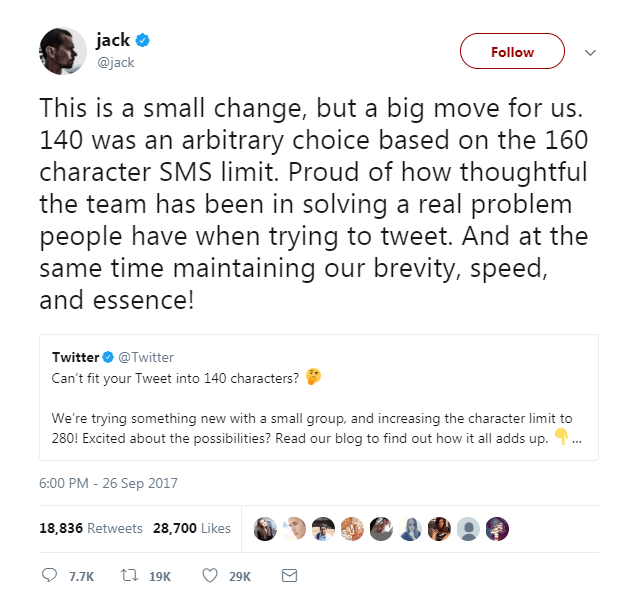
 280-character-tweets-debate-2
280-character-tweets-debate-2 
The Internet is all a-twitter with the news: instead of the 140-character limit that has existed since the inception of the network, some Twitter users are getting the ability to double their tweet length to a whopping 280 characters.
This news is dividing users sharply. Are longer tweets a good thing or a bad thing? Two members of DAC’s strategy team, Sari Stein and Melissa Chen, square off in this five-point debate.
Pro: More Is More, by Sari Stein
Huzzah! Twitter has granted me a great gift. 140 extra characters to play with on each and every tweet. Oh, the possibilities!
I’m all in favour of this change, and I hope it sticks around. Here are 5 reasons why:
-
The character limit was increasingly arbitrary
The original 140-character limit was created during a time when the limit of an SMS text message was 160 characters. This provided the ability to add a retweet prefix and still send a message by phone. However, this limit hasn’t existed in a long time, and most people are using apps on their phones to tweet anyway. Why should this relic stick around?
-
It’s good news for grammar nerds
Spelling, grammar and punctuation have all become casualties of the texting era. Twitter’s 140-character limit has forced otherwise intelligent business professionals to drop commas, apostrophes or even vowels in attempt to cram their thoughts into such a small space.
With double the character length, could this mean a return to full sentences? This is surely welcome news to us grammar nerds, for whom an improperly used apostrophe is as grating as the scrape of nails on a chalkboard. Will proper spelling once again become cool? Might we even see the return of prepositions, adjectives, or even an adverb or two?
-
It’s good news for nuance
Political discussion, debate and even policy increasingly take place on Twitter. And this is a big problem. Arguably, we’re as polarized as we’ve ever been. Twitter’s character limit hasn’t provided a lot of room for nuance, discussion or debate. To paraphrase Martin Sheen’s President Bartlet in The West Wing, You simply can’t reduce all thoughts to ten-word answers… or to 140-character tweets. A little extra space might lead to a little more thought, which can only be a good thing.
-
The public demanded it
This change is in response to user demand. First, links were automatically shortened. Next, images no longer counted against the character limit. Then, apps created workarounds for those who wanted to tweet a more complete thought. Tweet strings (multiple tweets posted as replies to one another, often enumerated as 4/10, 5/10, etc.) began to emerge. Platforms like Medium were created to provide a platform for longer-form text.
The truth is, people want to express longer thoughts. It’s been clear for some time that the 140-character limit was limiting Twitter’s growth. You can’t rest on your laurels in the rapidly changing world of social media; sometimes you need to evolve or die. Twitter is choosing to evolve. Good for them.
-
280 characters is still short
Twitter hasn’t turned into Medium or WordPress. 280 characters is still short enough to encourage bite-sized, scannable content. Our brains won’t be overly taxed with this change. It may even make me love Twitter again.
Con: Less Is More, by Melissa Chen
No. Hate it. Hope it’s nixed. Here’s why:
-
Brevity is the soul of wit
Twitter is pithiness. Astute observations in the least amount of words. If you can’t express an idea concisely in 140-characters, that doesn’t mean you need more space for more words. It just means you’re not a great writer.
This was the announcement tweet from Twitter CEO, Jack Dorsey, who is not a great writer. He was ripped to shreds by many great writers. One of whom was journalist Caitlin Kelly.
-
It’s bad news for grammar nerds
If u spell bad at 140-charcters, at 280-charcterz u have duble the space to spell worser!
More words don’t mean more accuracy. Being an “intelligent business professional” also doesn’t necessarily mean you have better spelling, grammar, and punctuation. If you’re truly a grammar nerd, you will make 140 characters work. If you’re not, then… mor sintences ain’t gon help.
-
Double length doesn’t mean double nuance
Yes, Twitter’s character limit doesn’t provide a lot of room for nuanced debate. But a shift to 280 characters will hardly change it. If you want to get into a meaty topic, you’ll need far more. And – let’s not forget – the real work after the Twitter storm takes place offline. Always.
-
Did we really demand it?
Character count barely registers on the user frustration scale. Consider what users really want addressed: hate speech, twitter bots, hashtag abuse, spam, ad-free paid twitter subscriptions. Platform asks include better-curated lists, edit functions, chronological timelines and better video functionality. These were the public tweets received by Twitter after asking for user feedback, late last year. Character limitations aren’t the cause of flat user growth and declines in revenue.
-
140 is Twitter’s heart and soul
“Why should this relic stick around?” Because that is the point. From a business perspective, it differentiates this platform from the hundreds of others out there. If you want to express thoughts in long-form – great! Go to Medium, Reddit, Quora, LinkedIn, or any number of other content platforms out there.
Or, write a blog post. Like this one.
Sari Stein is DAC’s Strategic Insights Director, and Melissa Chen is DAC’s Senior Strategist of Content. To learn more about digital content and strategic insights, please get in touch with DAC!



